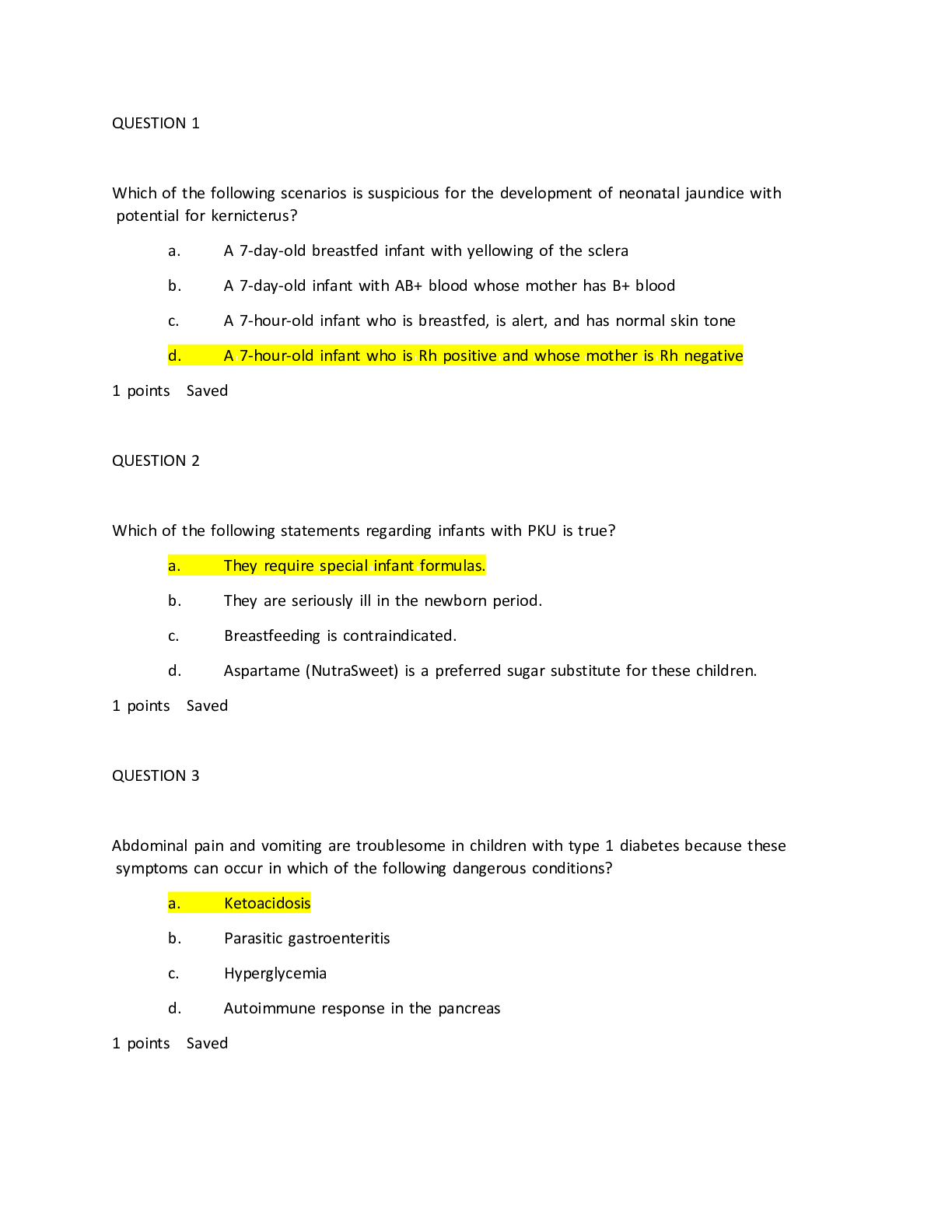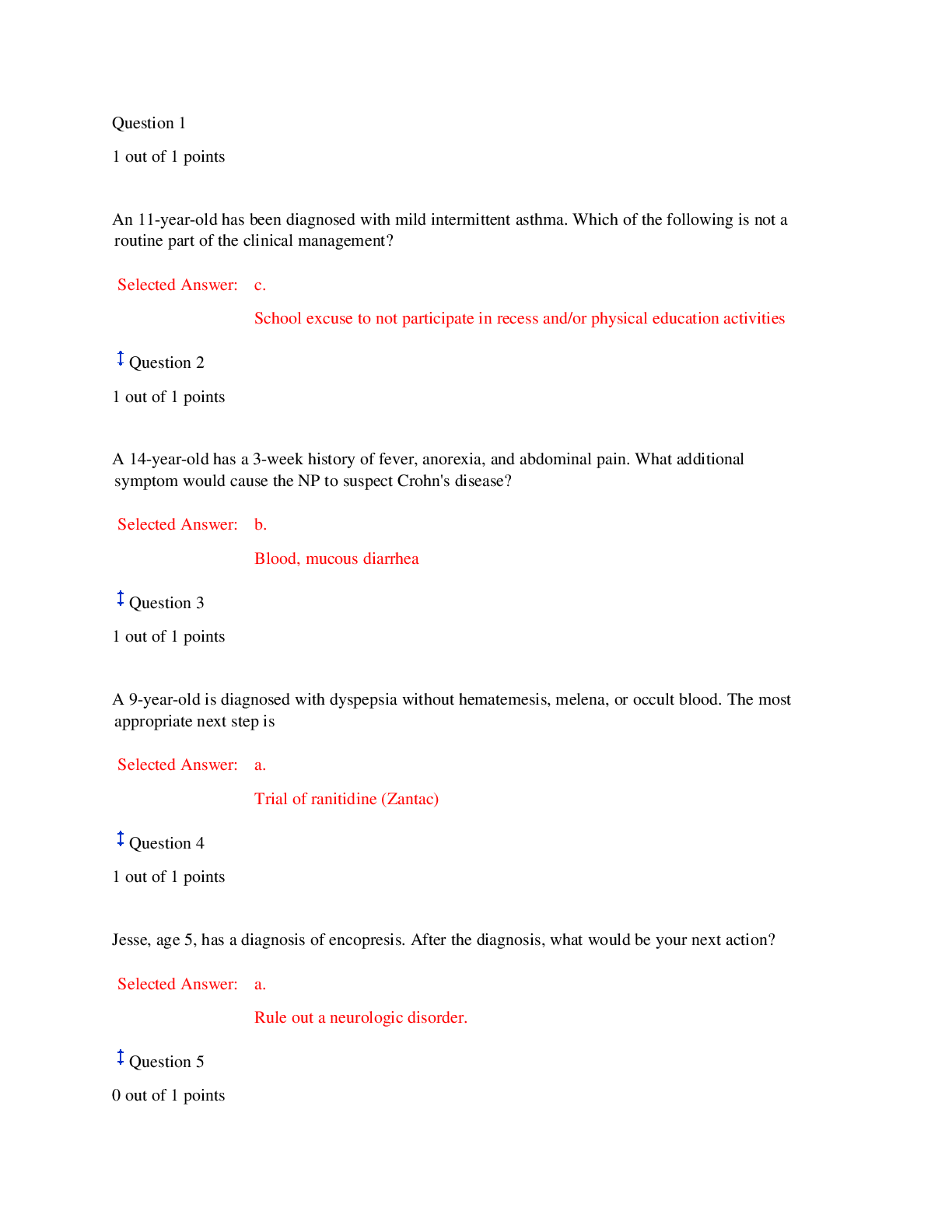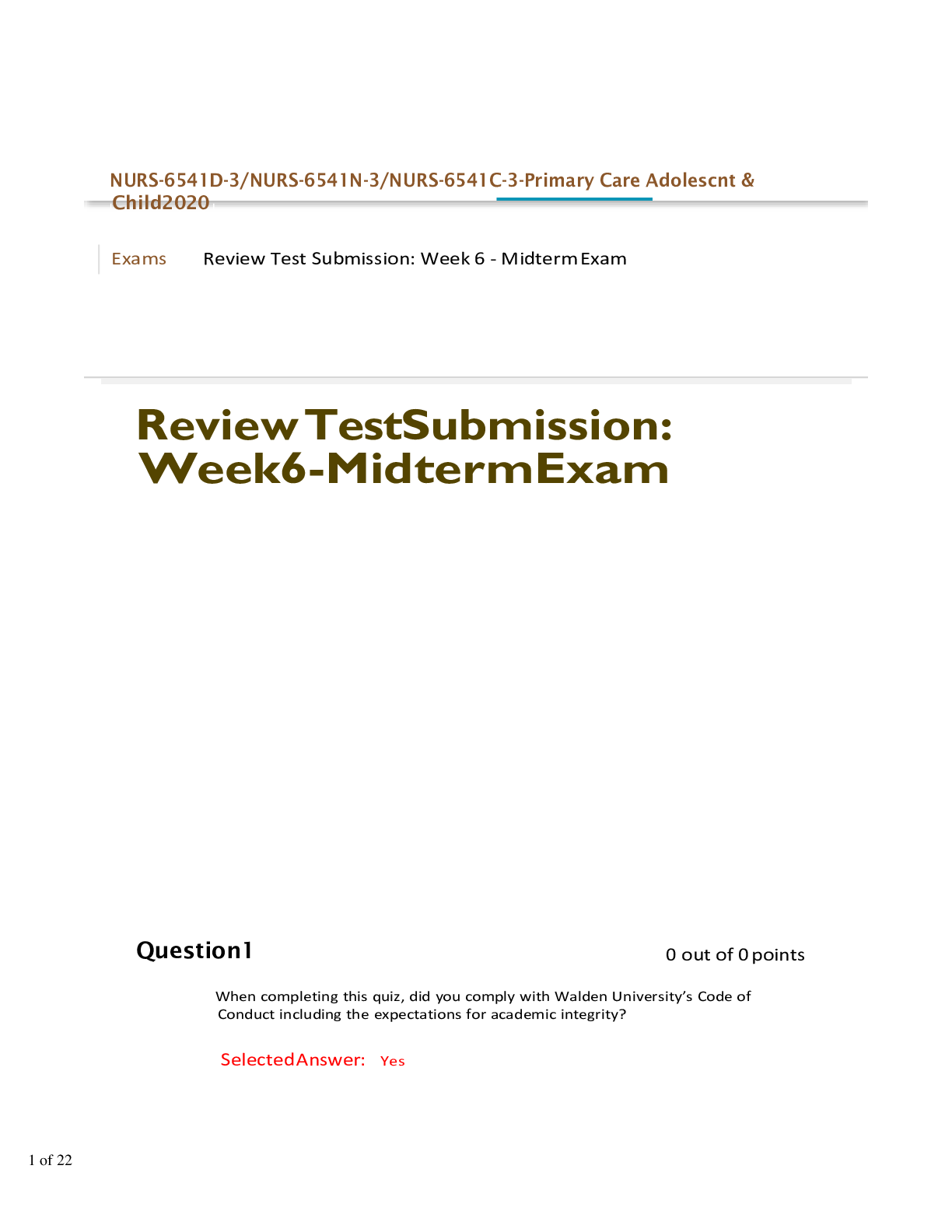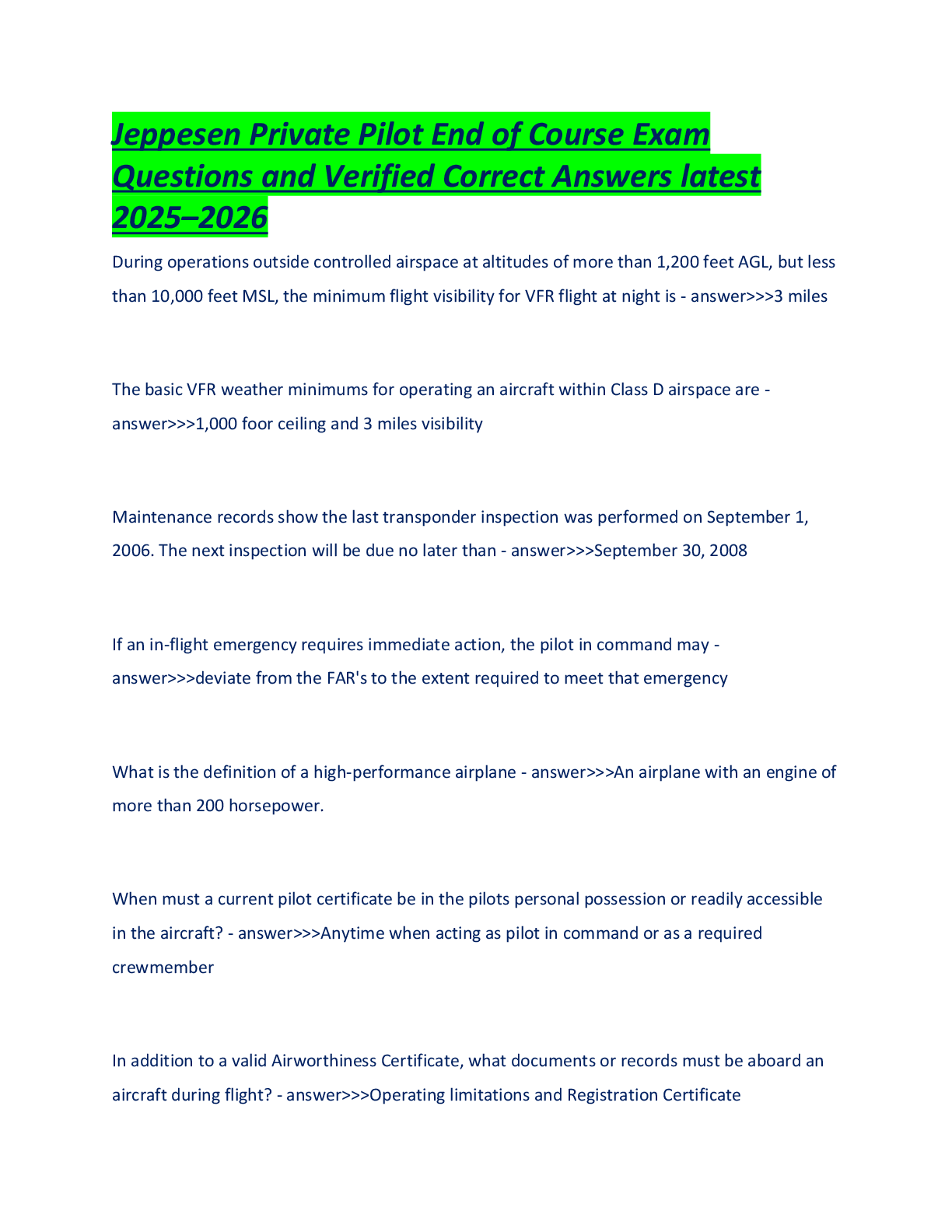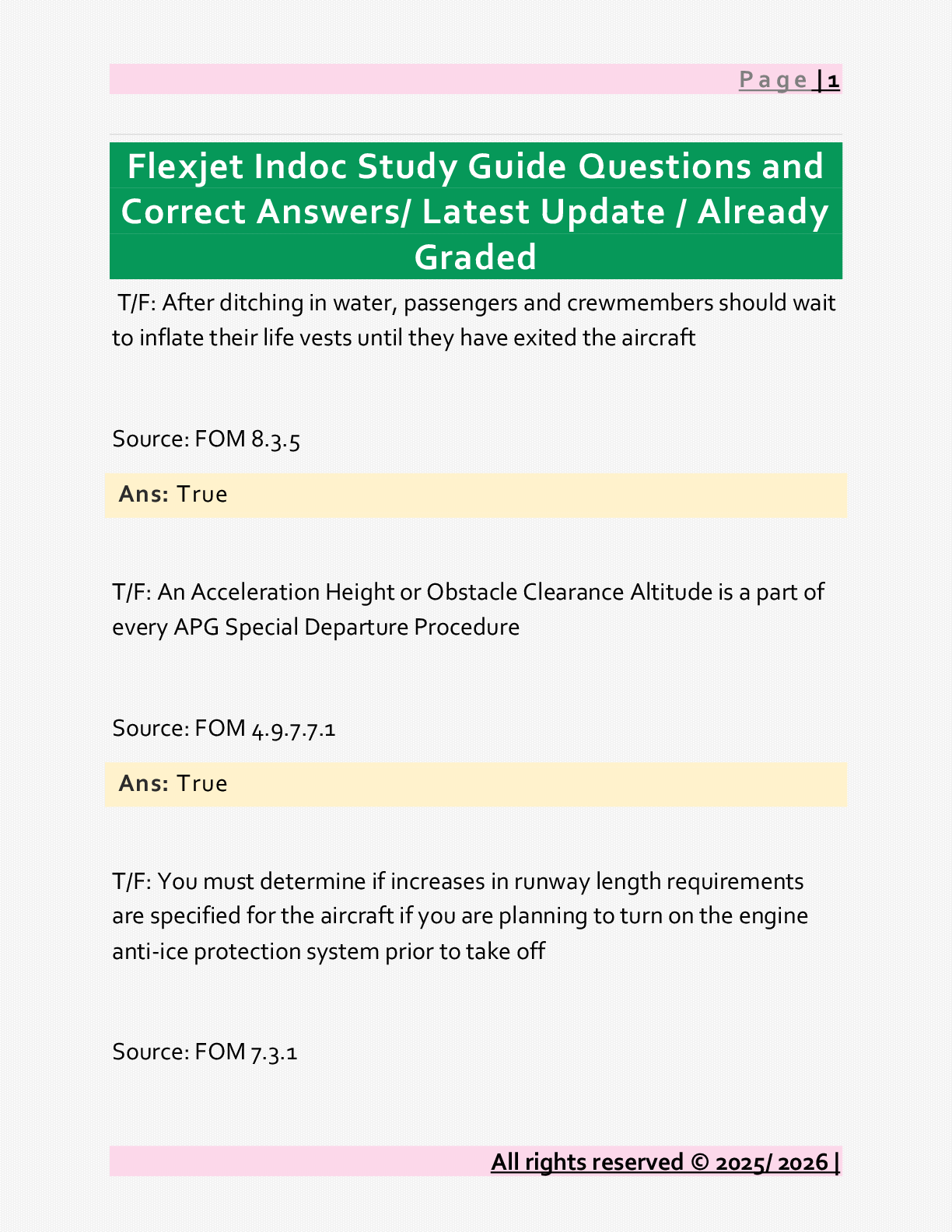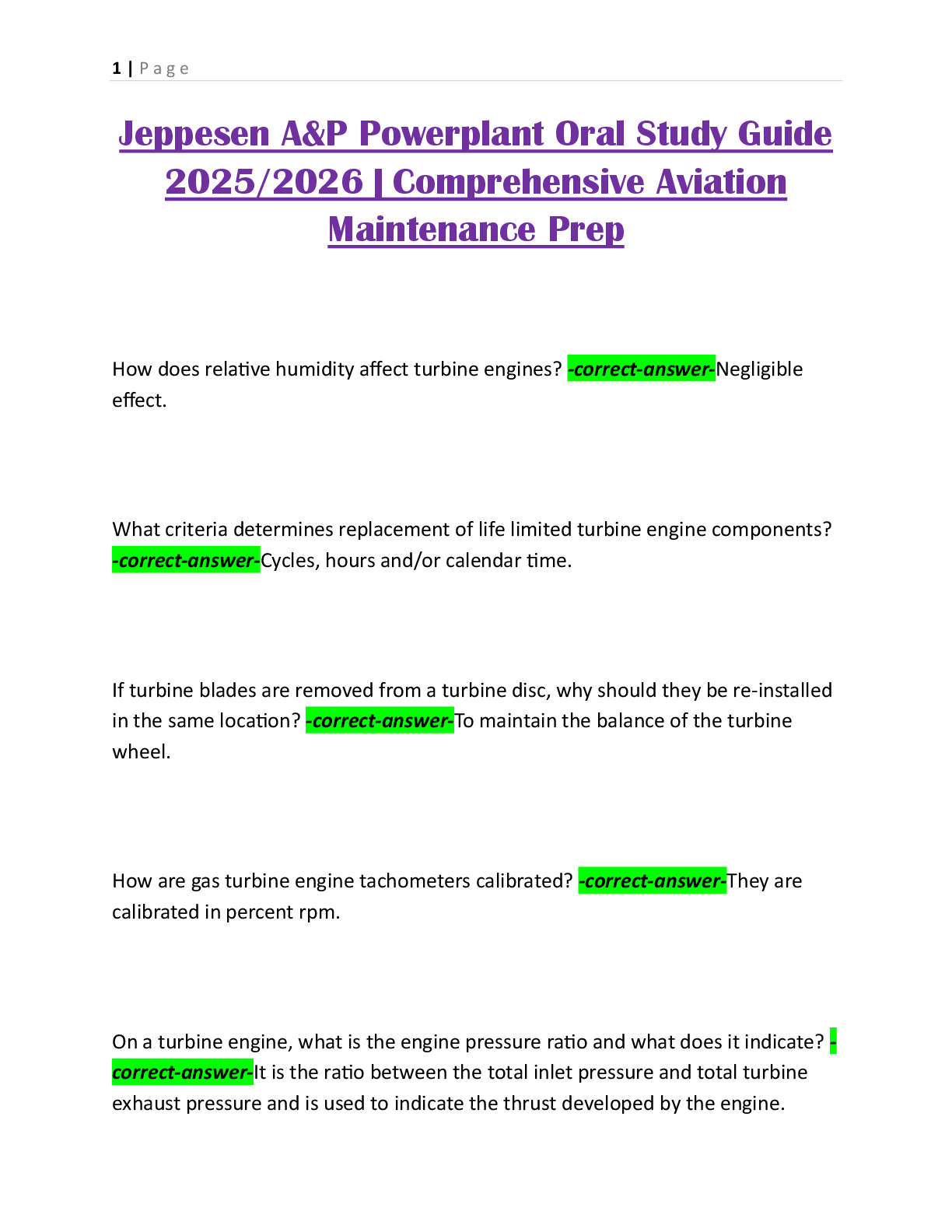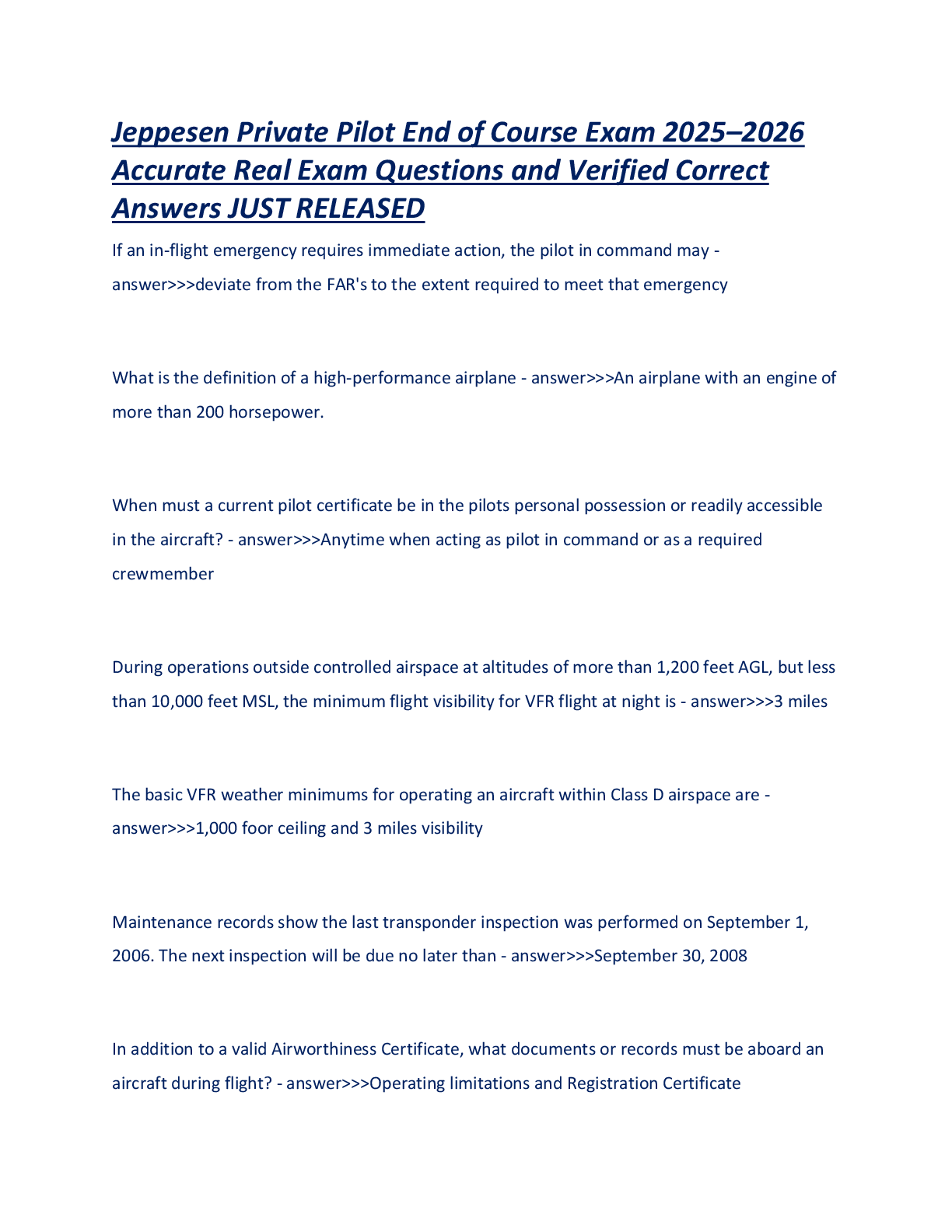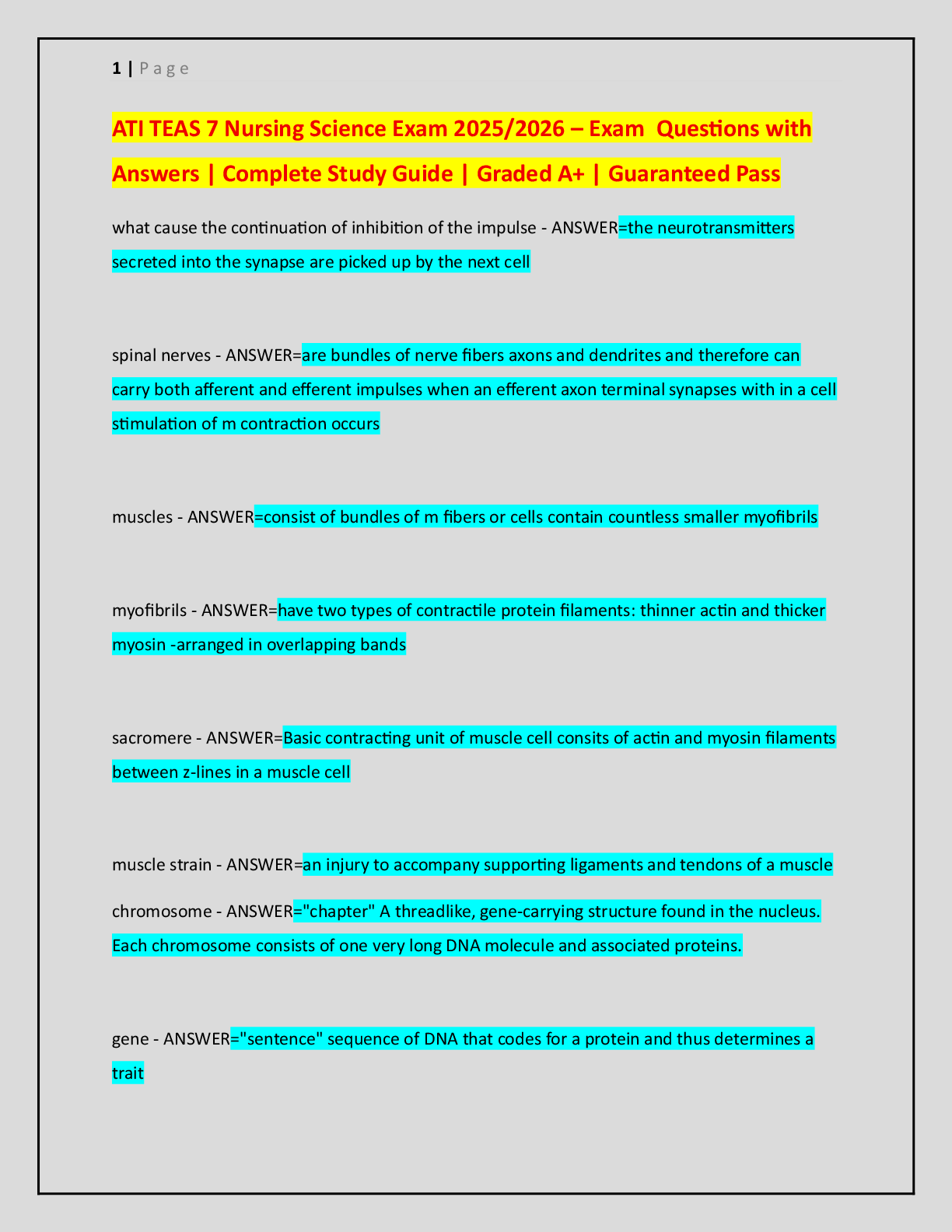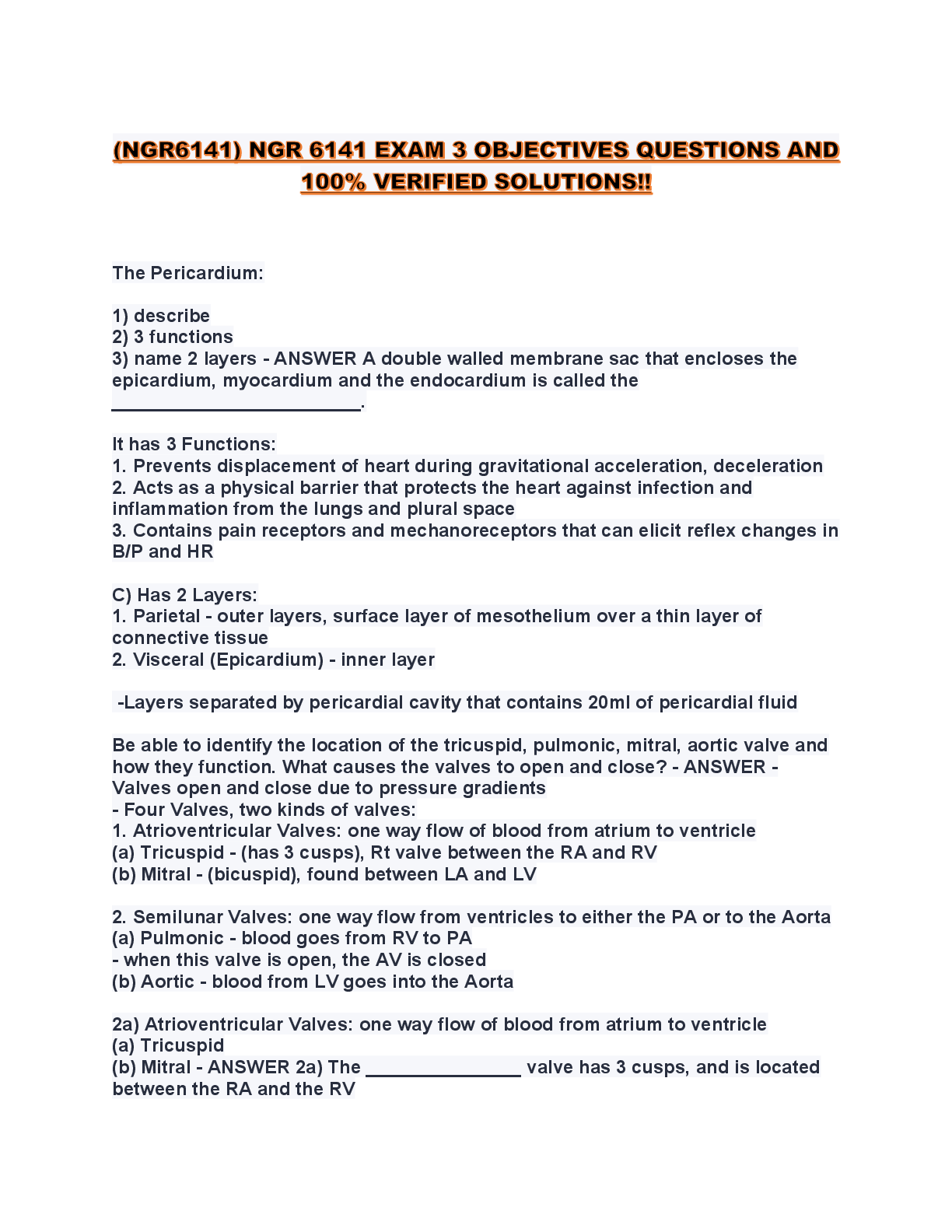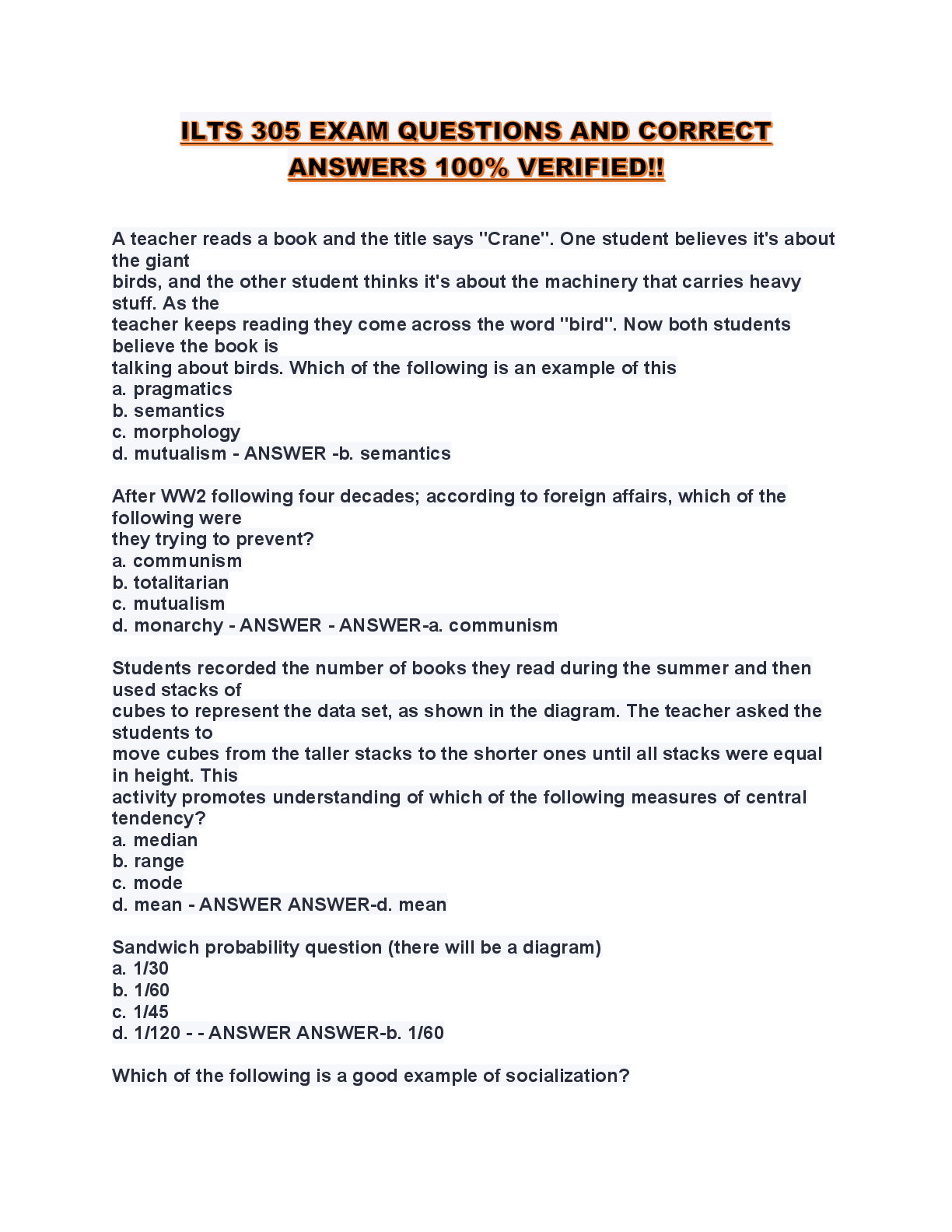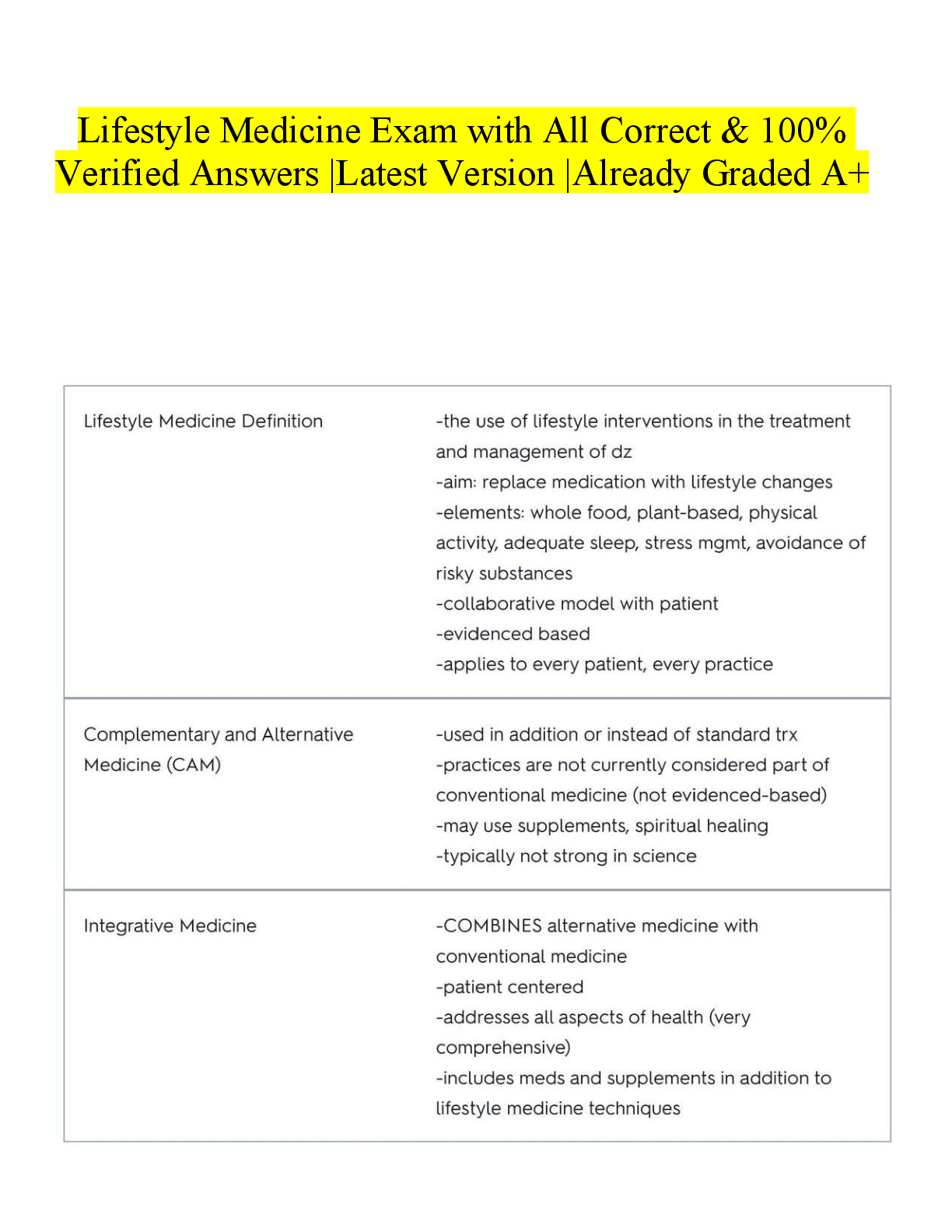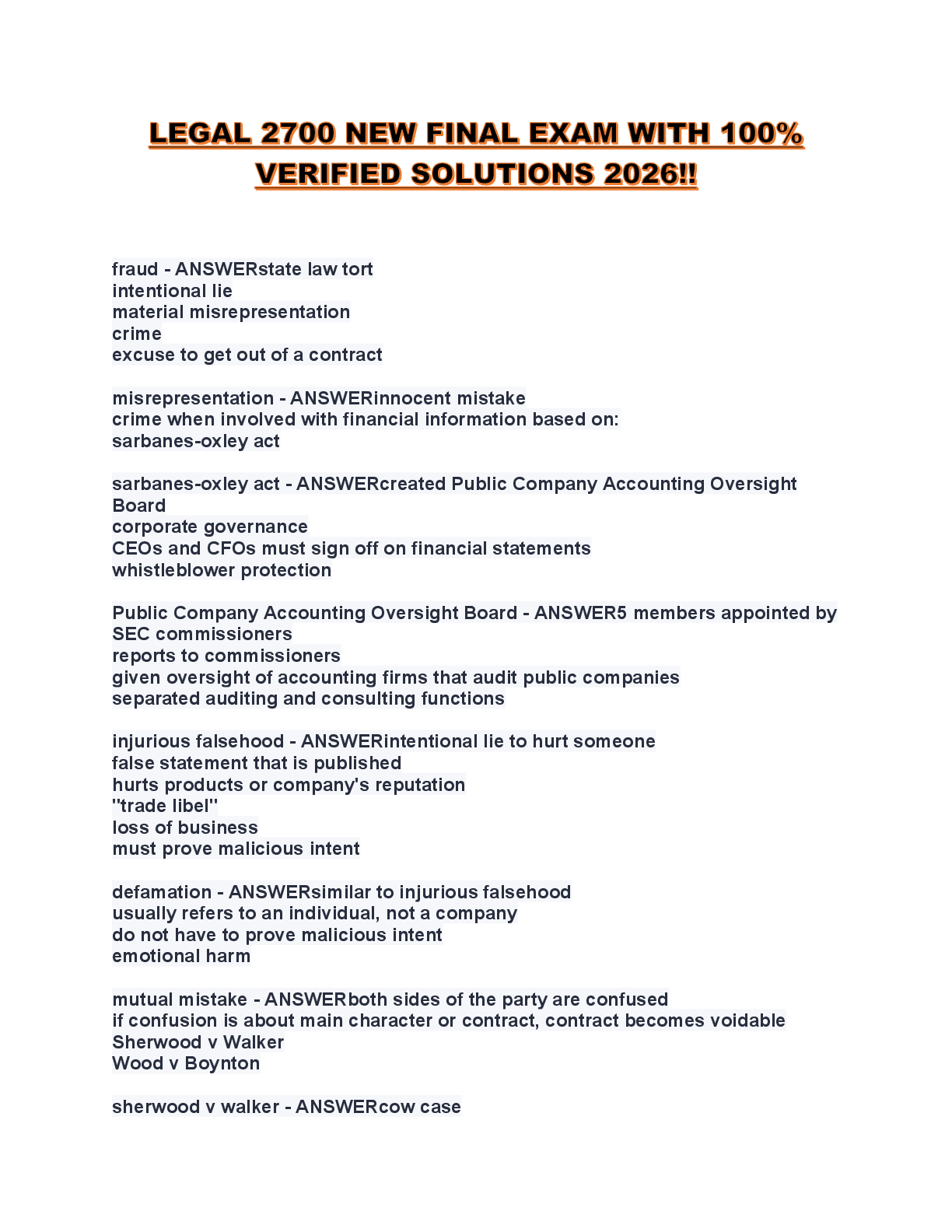NURS 6560 Final Exam Study Guide (Complete Guide for Exam Preparation)
Document Content and Description Below
NURS 6560 Final Exam Study Guide (Complete Guide for Exam Preparation) NURS 6560 Final Exam Study Guide Liver Biliary Tract, Pancreas, Spleen Resection of the liver and regeneration and follow up l ... abs pp 546-548 Types of Hepatic Resections: anatomical (based on segmental liver anatomy) and Follow Up Labs after Resection: Complications post op resection: include perihepatic fluid collectiaons which may require drainage, hepatic insufficiency (hyperbilirubinemia, ascites, coagulopathy) common but resolves, pleural effusions, atelectasis, and pneumonia (tx with aggressive pulmonary toilet post op). Hepatic Trauma: Hepatic Trauma Post op complications: Spontaneous Rupture of the Liver: Primary Liver Cancer: Hepatocellular Carcinoma (HCC): 85-95% of primary hepatic cancers Intrahepatic Cholangiocarcinoma: Treatment for Liver Cancer: Resection, translation, liver direct therapy, ethanol injection, ablation, embolization and systemic therapy Ethanol Injection: Tx for Liver Cancers: Radio-frequency Ablation (RFA): TX for Liver Cancers Arterial Embolization: TX for Liver Cancers Metastatic Neoplasms of the Liver: Hepatic hemangiomas : Hepatic adenomas: Cirrhosis: Acutely Bleeding Varices Treatment of Acute Bleeding Critical initial Steps: NON-Bleeding Varices Evaluation: Treatment for whose who have bled: Extrahepatic Portal Venous Occlusion (Doherty, 573) Splenic Vein Thrombosis (Doherty, 574) Splenectomy is curative. Budd-Chiari Syndrome (Doherty, 575) Hepatic Encephalopathy (Doherty, 577) Hepatic Abscess (Doherty, 579) Jaundice (icterus) Gallstones (Cholelithiasis) Acute Cholecystitis Emphysematous cholecystitis Cholangitis (bacterial cholangitis) Choledocholithiasis Pancreatitis Pancreatic pseudocyst CT scan is the diagnostic study of choice. Diff/DX Treatment Excision External drainage Internal drainage Nonsurgical drainagePancreatic insufficiency DX Test: Secretin or Cholecystokinin Pancreolauryl test Fecal Fat Balance Test Adenocarcinoma of the Pancreas S/Sx: carcinoma of the head of the pancreas presents with wt loss, obstructive jaundice, and deep-seated ABD pain in 75% of patients. Back pain occurs in 25% of patient and is associated with a worse prognosis. Smaller tumors of the pancreas have less pain Wt loss averages 20lbs (44kg) Hepatosplenomegaly present in half of patients but does not necessarily indicate spread to the liver. Palpable mass found in 20% of patients nearly always signifies surgical incurability Jaundice is unrelenting in most patients, fluctuates in about 10%. Jaundice is often accompanied by pruritus, especially of the hand and feet. Palpable nontender gallbladder in a jaundiced patient suggests neoplastic obstruction of the common duct (COURVOISIER sign) most often d/t pancreatic cancer this is present in about half patient Diff/DX: the other periampullary neoplasm carcinoma of the ampulla of Vater distal common bile duct or duodenum may also present with pain wt loss, obstructive jaundice and palpable gallbladder. Preoperative cholangiography and gastrointestinal xrays may suggest the correct diagnosis, but laparotomy may be required. Lab findings and test for: Treatment Hypersplenism (Doherty page 635): Overactive spleen, exaggeration of normal splenic function primarily associated with red pulp. In the past the term hypersplenism or increased splenic function have been used to denote the syndrome characterized by splenic enlargement, deficiency of one or more of the cell lines, normal or hyperplastic cellularity or deficient cell lines in the marrow, and increased turnover of the effected cells. Hypersplenism is not synonymous with hypersplenism. Differential diagnosis: Leukemia and lymphoma are diagnosed by marrow aspiration, lymph node biopsy, and examination of the peripheral blood (white count and differential). Spherocytosis there are spherocytes, osmotic fragility is increased, and platelets and white cells are normal. Thalassemia major become apparent in early childhood, and the blood smear morphology is characteristic. Myelofibrosis the bone marrow shows proliferation of fibroblasts and replacement of normal elements Idiopathic thrombocytopenia purpura (ITP) the spleen is normal or only slightly enlarged and the marrow is fatty. Diagnostic Studies: Before it become palpable an enlarged spleen may cause dullness to percussion above the left costal margin. Splenomegaly is manifested on supine x-ray of the abdomen by medical displacement of the stomach and downward displacement of the transverse colon and splenic flexure. CT scan is useful for differentiating the spleen from other abdominal masses and for demonstrating splenic enlargement or intrasplenic lesions. Treatment options (please see table 27 -2 on page 636 for surgery options): nurs 6560 final exam The course, response to treatment and prognosis of hyper-splenic syndromes differ widely depending one the underlying disease and its response to treatment and will be decided for or against splenectomy. Splenectomy may decrease transfusion requirements decrease the incidence and number of infections and prevent hemorrhage and reduce pain. The course of congestive splenomegaly due to portal hypertension depends upon the degree of venous obstruction and liver damage. Hypersplenism is rarely a major problem and is almost always overshadowed by variceal bleeding or liver dysfunction. Chronic Lymphocytic Leukemia (pg. 637) CLL is a low-grade neoplasm of B cell lineage characterized by accumulations of populations of lymphocytes that are mature morphologically but functionally incompetent. Makes up 25-30% of all leukemias, mean age dx of 72 Initially causes little to no pain, eventually causes massive splenomegaly. Most symptoms related to the spleen are from thrombocytopenia and anemia due to hypersplenism. Decreased cellular production from the bone marrow is another cause of cytopenia. Splenectomy corrects thrombocytopenia in 70-85% of cases, neutropenia is 60-70% of cases, and anemia in 50-60% of cases. Myelodysplastic Syndrome (pg. 637) Heterogenous group of clinical hematopoietic stem cell disorders manifested by pancytopenias, and dysplasia of the bone marrow. Pathologic changes include extensive bone marrow fibrosis, extramedullary hematopoiesis in the spleen and liver, and a leukoerythroblastic blood reaction that may evolve into acute myeloid leukemia over time. Bone marrow is usually completely replaced by fibrous tissue. Symptoms are attributable to anemia (weakness, fatigue, dyspnea) and to splenomegaly (abd fullness, pain). Pain over spleen from splenic infarcts is common. nurs 6560 final exam Spontaneous bleeding, fatigue, secondary infection, bone pain, and hypermetabolic state are frequent. Portal hypertension develops in some cases as a result of fibrosis of the liver, increased splenic blood flow or both. Hepatomegaly is present in 75% of cases and splenomegaly with a firm and irregular spleen in all cases. Splenectomy often provides relief. Treatment Primarily supportive using transfusions, androgenic steroids, antimetabolites and hematopoietic growth factors. New therapies include immunomodulatory drugs like thalidomide or antibodies to VEGF and TNF. Splenectomy indicated in the following: major hemolysis unresponsive to medical treatment, severe symptoms of massive splenomegaly with mass effect of the spleen, life threatening thrombocytopenia, portal hypertension with variceal hemorrhage Hemolytic Anemia (pg. 641) Essentials of diagnosis Signs and Symptoms Laboratory Findings Immune Thrombocytopenia Purpura (ITP) (pg. 642) Essentials of diagnosis General considerations Symptoms and signs Laboratory findings Differential diagnosis Treatment Prognosis Intestines, Hernias, and Abdominal Wall Lesions Small Bowel Obstruction: Enteritis: Crohns Disease: Mesenteric Ischemia: Short bowel syndrome Constipation Acute symptoms <3 months Key Factors 1st Tests To Order CBC serum electrolytes renal function serum amylase/lipase coagulation studies erect chest x-ray plain abdominal x-ray Consider malignancy in all patients who present with large bowel obstruction. Suspect bowel perforation where there is persistent tachycardia, fever, and/or abdominal pain and tenderness Differentials- acute colonic pseudo-obstruction, chronic/idiopathic megacolon, toxic megacolon, endometriosis Treatment Options: Presumptive- acutely ill: supportive measures, suspected or impending perforation, emergency surgery Acute-sigmoid volvulus nurs 6560 final exam no peritonitisor mucosal gangrene flexible or rigid sigmoidoscopy surgery peritonitis or mucosal gangrene surgery cecal volvulus surgery colorectal malignancy surgery endoscopic stenting diverticular disease surgery endoscopic stenting foreign body ingestion transluminal removal or laparotomy benign strictures treat underlying cause endometriosis resection pelvic abscess percutaneous or transrectal drainage resection Cancer – Third leading cause of cancer deaths in the US in men and women. Rare below 40 years of age. Key Factors Other Factors o 1st Tests To Order Treatment Options: Acute rectal cancer, suitable for surgery [Show More]
Last updated: 3 years ago
Preview 1 out of 53 pages

Buy this document to get the full access instantly
Instant Download Access after purchase
Buy NowInstant download
We Accept:

Reviews( 0 )
$15.00
Can't find what you want? Try our AI powered Search
Document information
Connected school, study & course
About the document
Uploaded On
Dec 06, 2020
Number of pages
53
Written in
All
Additional information
This document has been written for:
Uploaded
Dec 06, 2020
Downloads
0
Views
97

